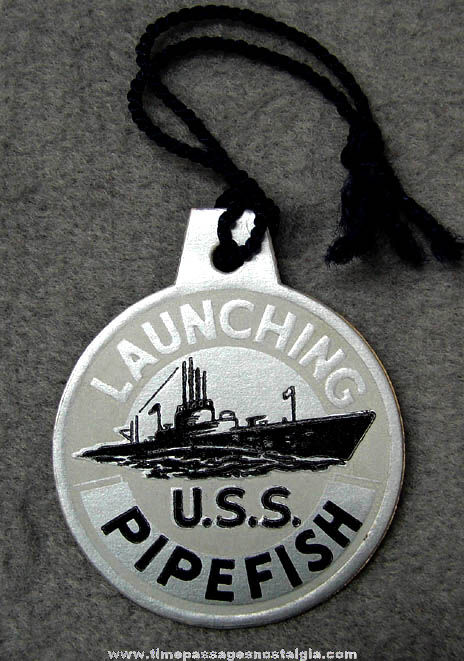
   | | | Any group of items being offered as a lot must be sold as a lot. | | You don't have to be an eight year old to enjoy having
a childhood treasure. | All Original Items.
No Reproductions | Nostalgic Memorabilia, Pop Culture Artifacts, Historic Items,
and "Shoe Box Toys" | Quality Packing And
Postal Insurance | Whether you've collected Memorabilia for years or just want to feel like a kid again, please take a few moments to browse through what we
have available for sale. | | An Ever Changing Inventory | Great memories
make great gifts! | | Combined Shipping And Handling |
| | | | The picture shows a view of this 1943 U.S.S. Pipefish SS-388 Submarine Launching Souvenir Tag. This launching badge is believed to have been saved by a Portsmouth Naval Shipyard worker. It was found in Maine with many others dating from 1943 to 1944 when many ships and submarines were built and launched to do battle in World War II. They had been hidden away since the 1940s until 2009. The submarine was launched from The Portsmouth Naval Ship Yard in Kittery, Maine. This cardboard tag has its original black cord attached. It is imprinted in black and gray on a silver background. The back side is identical. It pictures a United States Navy Submarine and it is marked on both sides as follows: LAUNCHING
U.S.S. PIPEFISH The tag measures 1-3/4'' wide. It is in mint condition as pictured. Below here, for reference, is some historical information on the U.S.S. Pipefish SS-388 submarine: U.S.S. Pipefish (SS-388)
From Wikipedia, the free encyclopediaCareer (United States) Builder: Portsmouth Naval Shipyard, Kittery, Maine
Laid down: 31 May 1943
Launched: 12 October 1943
Sponsored by: Mrs. George J. Bates
Commissioned: 22 January 1944
Decommissioned: 19 March 1946
Reclassified: AGSS-388, 1 December 1962
Struck: 1 March 1967
Fate: Sold for scrap on 4 February 1969 General characteristics Class and type: Balao class diesel electric submarine
Displacement: 1,526 tons (1,550 t) surfaced, 2,391 tons (2,429 t) submerged
Length: 311 ft. 6 in. (94.9 m)
Beam: 27 ft. 3 in. (8.3 m)
Draft: 16 ft. 10 in. (5.1 m) maximum
Propulsion: 4 Fairbanks-Morse Model 38D8, 10 cylinder opposed piston diesel engines driving electrical generators, 2 126-cell Sargo batteries,
4 high speed Elliott electric motors with reduction gears, two propellers, 5,400 shp (4.0 MW) surfaced, 2,740 shp (2.0 MW) submerged
Speed: 20.25 kn (37.50 km/h) surfaced, 8.75 kn (16.20 km/h) submerged
Range: 11,000 nmi (20,000 km) at 10 kn (19 km/h) surfaced
Endurance: 48 hours at 2 kn (3.7 km/h) submerged, 75 days on patrol
Test depth: 400 ft. (120 m)
Complement: 10 officers, 70 - 71 enlisted
Armament: 10 21-inch (533 mm) torpedo tubes (six forward, four aft), 24 torpedoes, 1 5-inch (127 mm) / 25Ęcaliber deck gun, four machine gunsU.S.S. Pipefish (SS-388/AGSS-388), a Balao class submarine, was the only ship of the United States Navy to be named for the pipefish, a long, narrow, bony scaled fish with straight, tubular snout found in Panama that has extraordinary powers of concealment in vegetation. Pipefish was laid down on 31 May 1943 by the Portsmouth Navy Yard. She was launched on 12 October 1943 sponsored by Mrs. George J. Bates, and commissioned on 22 January 1944, Lieutenant Commander William N. Deragon in command. Service History Following training off the East Coast, Pipefish proceeded via the Panama Canal to Pearl Harbor, where she arrived on 3 May 1944. On her first war patrol from 24 May - 16 July Pipefish cruised west of the Mariana Islands, as a rescue submarine for pre-invasion carrier strikes on Saipan, saving one pilot on 12 June. She also cruised in the Surigao Straits to block Japanese escape from the Battle of the Philippine Sea. She moored at Majuro on 16 July. On her second war patrol - 6 August-27 September - she patrolled off the southeastern coast of Honsh, Japan. Pipefish sank Hakutetsu Maru Number Seven on 12 September. While evading escorts after that attack, she struck bottom three times. She returned to Pearl Harbor on 27 September. On her third war patrol from 28 October 1944 to 6 January 1945, Pipefish roamed southwest of Taiwan and off the east coast of Hainan Island, China, operating with the USS Pampanito, USS Sea Cat, and USS Searaven. On 30 November Pipefish was damaged from an air attack but remained on patrol in the South China Sea. Attacking a convoy, Pipefish sank Coastal Defense Vessel Number 64 on 3 December. She arrived at Majuro on 6 January. On her fourth war patrol from 31 January to 26 March Pipefish provided rescue capability for downed aviators in the Nansei Shoto area. During her fifth war patrol from 28 April - 16 June she performed lifeguard duty for B-29 Superfortress aviators off Honsh, and in the Nanp Islands area. Pipefish saved eight aviators on 26 May, 29 May, and 10 June. She moored at Midway Island on 16 June. Her sixth war patrol from 15 July - 28 August called for lifeguard duty in the Nanp Islands area and off the east coast of Kysh. On patrol she destroyed eight naval mines. Following termination of hostilities with Japan she arrived at Pearl Harbor on 28 August, and then proceeded to the West Coast. The U.S.S. Pipefish was decommissioned on 19 March 1946, and joined the Pacific Reserve Fleet. She was redesignated as AGSS-388 on 1 December 1962. She was struck from the Naval Vessel Register on 1 March 1967 and sold on 20 January 1969. Pipefish received six battle stars for her World War II service. |
|
Click on image to zoom.
 |